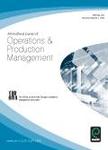版权所有:内蒙古大学图书馆 技术提供:维普资讯• 智图
内蒙古自治区呼和浩特市赛罕区大学西街235号 邮编: 010021

作者机构:Univ Fed Paraiba Dept Ind Engn Joao Pessoa Brazil Nove de Julho Univ Ind Engn Post Grad Program Sao Paulo Brazil
出 版 物:《INTERNATIONAL JOURNAL OF OPERATIONS & PRODUCTION MANAGEMENT》 (国际经营与生产管理杂志)
年 卷 期:2012年第32卷第12期
页 面:1427-1440页
核心收录:
学科分类:12[管理学] 120202[管理学-企业管理(含:财务管理、市场营销、人力资源管理)] 0202[经济学-应用经济学] 02[经济学] 1202[管理学-工商管理] 1201[管理学-管理科学与工程(可授管理学、工学学位)]
主 题:Operations management teaching Active learning Work measurement Assembly line balancing Operations management Assembly lines
摘 要:Purpose - The paper aims to present a hands-on activity for operations management (OM) education that simulates assembly operations common in industrial settings using polyvinyl chloride (PVC) threadable fittings utilised in water pipes as interchangeable parts for easy manual assembly. Design/methodology/approach - The teaching method followed the philosophy of active learning and was applied in an action research approach;the proposed activity was tested and improved during applications in the classroom. Findings - The applicability of the method was proven during in-class exercises. The results were confirmed with positive feedback from the students involved in the exercises, which was obtained through a survey conducted after a set of applications. Research limitations/implications - Although the proposed activity may have several possibilities for application, this paper focuses specifically on teaching the topics of work measurement and assembly line balancing, thus limiting the generalisability of these findings to other OM techniques. Therefore, it is important that the activity is further adapted to teach other OM topics. Practical implications - The activity performed with pipe fittings represents a practical exercise that contributes to reduction of the gap between theory and practice in OM education. Using simple and low cost materials, the students are involved in creating a real process from a fictional product. Originality/value - This paper presents an experiential learning exercise applied using an innovative approach, using pipe fittings as interchangeable parts assembled in a production line.